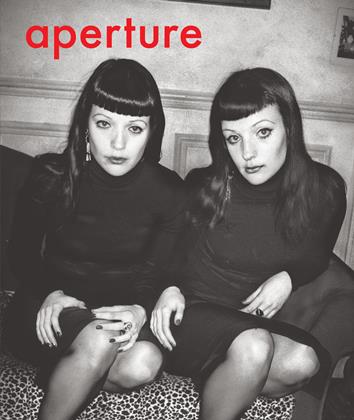NOTE
If we were to give a name to this issue of Aperture, we might take our cue (with a bit of leeway) from the great mystic G. I. Gurdjieff, and call it “Meetings with Remarkable Men (and a Few Women).” The encounters and discussions in the following pages are catalytic in the truest sense: each of them brings something new and unexpected to light.
We open with two of photography’s grandees: Elliott Erwitt and Marc Riboud, longtime friends and Magnum colleagues. Writer Amanda Flopkinson met with the two in London recently and shepherded a spirited dialogue—sometimes wryly contentious, sometimes enthusiastically in accord—that culminated in each of the photographers choosing and discussing an image of interest by the other.
Influential Swedish photographer Anders Petersen is interviewed by JH Engström. The two photographers, who recently collaborated on the award-winning book From Back Home, discuss Peterson’s intensive studies of humanity, which for nearly forty years have brought him into nightclubs, prisons, hospitals, and homes for the elderly. Though the venues have changed, Petersen’s work through the years has had a consistent focus—as he puts it: “People. Always people. I like people.”
Photographer Paolo Pellegrin and journalist Scott Anderson have worked in some of the most troubled locations on the globe, including Sudan and Lebanon. In 2008 they traveled to Jordan and Syria to interview Iraqi citizens who have fled their home country. All have seen and experienced unspeakable brutality in Iraq; few have any intention of going back. Pellegrin and Anderson also visited Iraqi patients of Médecins Sans Frontières based at the Kasser Jaddah Hotel in Amman—a kind of purgatory of peace and recuperation before their inevitable return to Iraq and the violence that brought them here.
The pictorial archive as record and conceptual platform is investigated in two very different ways by artists Walid Raad and Zoe Crosher. Raad’s Atlas Group utilizes the form of an archive to explore the contemporary history of Lebanon. Alan Gilbert discusses the artist’s inventive process and thoughtprovoking approach. And Crosher takes on the photographic self-documentation of mercurial protagonist Michelle duBois, whom author Jan Tumlir describes as a kind of “Cindy Sherman, avant Ia lettre.” Both Raad and Crasher’s projects raise questions about how history is documented, interpreted, and fabricated.
Mary Panzer takes us on a tour through the pages of Holiday, whose publication run—from 1946 to 1977—spanned much of the era of the Great American Illustrated Magazine. The journal, created fora curious and energized postwar readership eager to travel the world, brilliantly paired photographs by such luminaries as Arnold Newman, Burt Glinn, Slim Aarons, and Dan Weiner with writings by William Faulkner, Mary McCarthy, Kenneth Tynan, Nadine Gordimer, and many others.
John Gossage’s recent foray into color work is seen in his upcoming volume The Thirty-Two Inch Ruler/ Map of Babylon. The book is a double feature: Read in one direction, it presents a mordant study of Washington, D.C.’s, upscale Kalorama neighborhood—home to many movers and shakers of both the U.S. and foreign governments. Read the other way, the book presents a pithy collection of unsettling still lifes. Gerry Badger discusses the interplay of ideas in this tandem approach.
German photographer Robert Voit is clearly bemused by the encounter between nature and technology, as seen in his series New Trees: photographs of cell-phone towers (not-so-cleverly) disguised as arboreal specimens. These deadpan images, made in locations from Arizona to South Africa, comment on humanity’s left-footed attempts to subordinate the natural world to our own purposes.
Nature delivers a thundering—and very serious—riposte through the images of celebrated environmental photographer and advocate James Balog. His most recent undertaking is the massive Extreme Ice Survey: a global study of the rapid depletion of our planet’s glaciers due to climate change. Interviewed here by Fred Ritchin, Balog stresses the vital importance of giving a voice to the imperiled landscape—and acting upon what it has to tell us.
Finally, in “Mind’s Eye,” David Cole considers the quandary of the Guantánamo Bay detention center in his discussion of a photograph representing one president’s exit and another’s entrance.
The Editors
 View Full Issue
View Full Issue
More From This Issue
-
 Witness
WitnessThe Iraqi Diaspora
Spring 2010 By Scott Anderson, Paolo Pellegrin -
 Work And Process
Work And ProcessWalid Raad (re)invents The Archive
Spring 2010 By Alan Gilbert -
 Dialogue
DialogueAnders Petersen Finding A Fever
Spring 2010 By The Editors, Jh Engström -
 Close Encounters
Close EncountersHead To Head: A Conversation With Marc Riboud & Elliott Erwitt
Spring 2010 By Amanda Hopkinson -
 Artist's Project
Artist's ProjectJohn Gossage
Spring 2010 By Gerry Badger -
 Archive
ArchiveFemme Fatale Zoe Crosher's Reconsidered Archive Of Michelle Du Bois
Spring 2010 By Jan Tumlir
Subscribers can unlock every article Aperture has ever published Subscribe Now
The Editors
-
 Editor's Note
Editor's NoteFiction And Metaphor
Summer 1986 By The Editors -
 Editor's Note
Editor's NoteDark Days: Mystery, Murder, Mayhem
Fall 1997 By The Editors -
 Editor's Note
Editor's NotePhotographers On Photographers
Spring 1998 By The Editors -
 Note
NoteNote
Fall 2012 By The Editors -
 Back
BackObject Lessons
Summer 2014 By The Editors -
 Object Lessons
Object LessonsPrints From Blow-Up, 1966
Fall 2014 By The Editors







